On View
Gustav Klimt and His 7 Muses Take Center Stage at New York’s Neue Galerie
The exhibition mounts a truly historic reunion of Klimt's portraits of women.
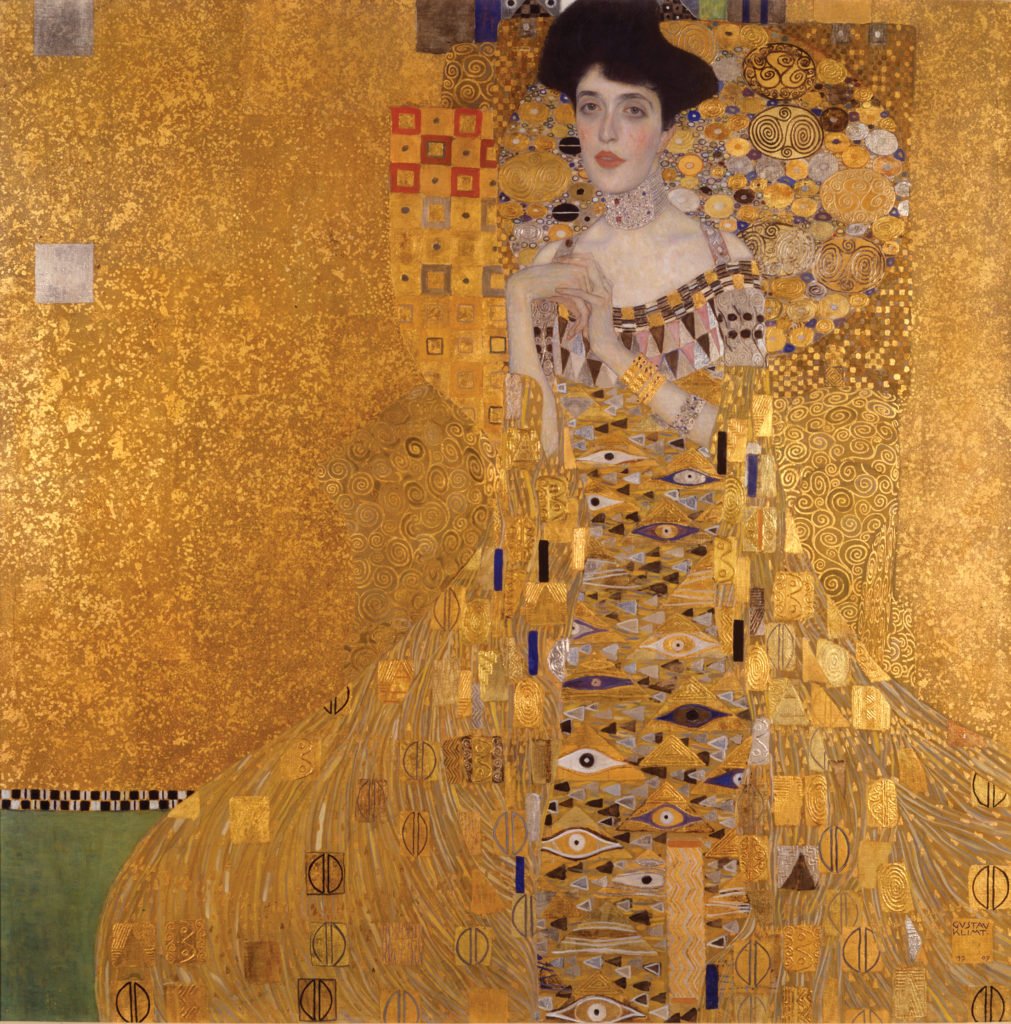
The exhibition mounts a truly historic reunion of Klimt's portraits of women.

How much mileage can one museum get out of a single painting? A fair amount, it turns out, if the museum is New York’s Neue Galerie and the painting is Adele Bloch-Bauer I, Gustav Klimt’s iconic “The Woman in Gold.”
As a follow-up to last year’s “Gustav Klimt and Adele Bloch-Bauer: The Woman in Gold,” the museum has mounted “Klimt and the Women of Vienna’s Golden Age, 1900–1918,” a tribute to Bloch-Bauer and the other well-dressed beauties who provided the Austrian Secessionist artist with so much inspiration.
The exhibition positions “The Woman in Gold” as its “climax,” demonstrating Klimt’s gradual adoption of “geometric ornamentation that encases the women.” The show does illustrate this progression, starting with the relatively colorless, narrow Portrait of Gertha Loew (1902) and Portrait of Szerena Lderer (1899).
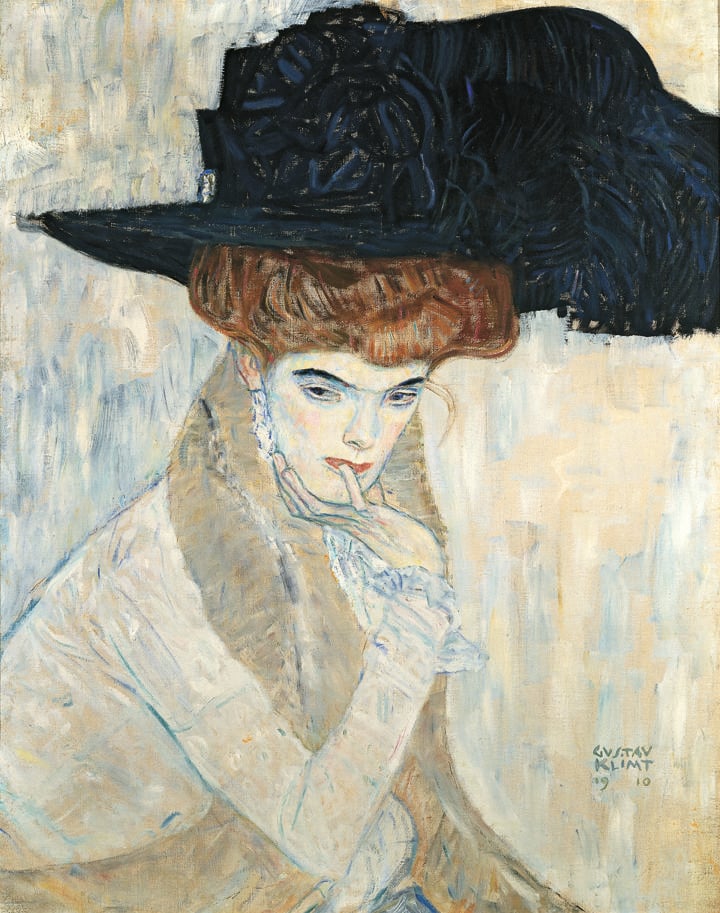
Gustav Klimt, The Black Feather Hat (1910). Courtesy of the Neue Galerie.
Both women are depicted delicately, in pale diaphanous gowns. The Loew canvas includes a tiny pop of color in the sitter’s golden ring, and several small green squares floating in the upper left corner. These accents seem to presage the liberal use of gold leaf and patterned cubes later employed by the artist.
The rest of the exhibition, however, steps out of chronological order, as the famed Bloch-Bauer canvas that closes the show is actually among the earlier works on view. An allegedly Henri Toulouse-Lautrec-inspired portrait, The Black Feathered Hat, shares muted hues with the first two works, with similarly cool white tones used in the woman’s face, as well as her gown and the background, but the canvas was painted in 1910, three years after Klimt’s opulent masterpiece in 1907.
The other portraits all come later, and they see the artist replacing the glittering gold blocks of Adele Bloch-Bauer I with densely colorful backdrops with flowers, jewel-toned geometric shapes, and, in the case of the Portrait of Elisabeth Lederer (1914–16), even an Oriental motif of tiny men and women. This includes the second Bloch-Bauer canvas, from 1912.
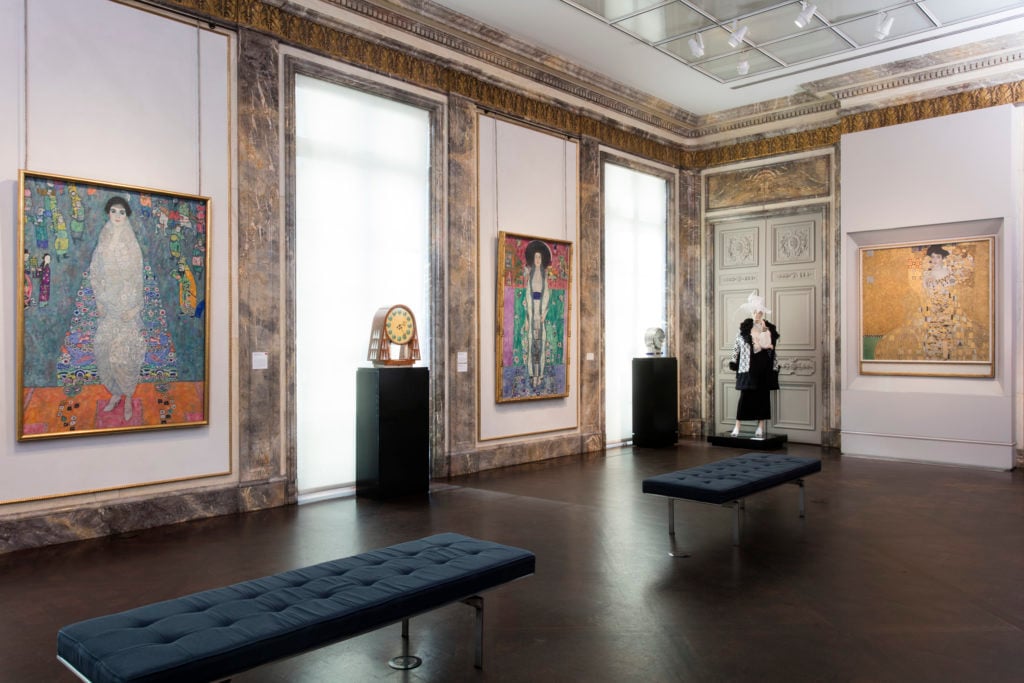
Installation shot of “Klimt and the Women of Vienna’s Golden Age, 1900–1918.” Courtesy of the Neue Galerie.
The Neue Galerie was quick to bill the exhibition as a rare chance to see the two Bloch-Bauer portraits side-by-side. The paintings haven’t been shown together since they were sold by the sitter’s descendants a decade ago, after a drawn-out Nazi restitution case was resolved in their favor.
This is significant in that Bloch-Bauer was the only person for whom the artist painted two full-length portraits. The truly historic reunion, however, is that the paintings of Elisabeth Lederer and her mother Szerena are been shown together publicly here for the first time.
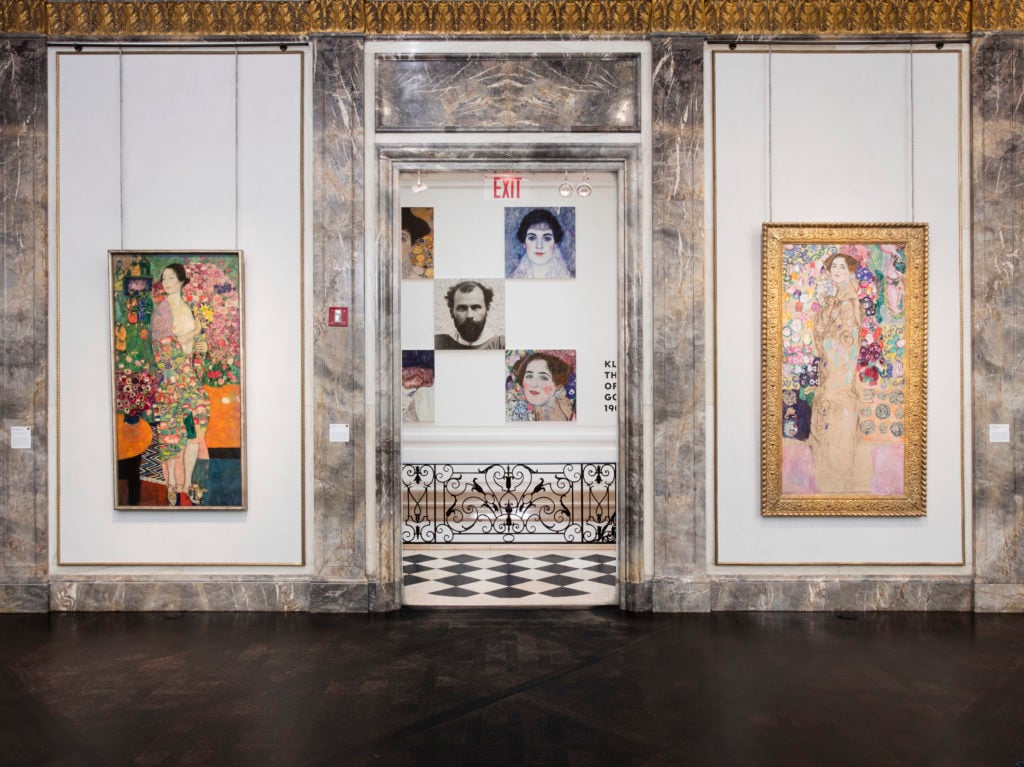
Installation shot of “Klimt and the Women of Vienna’s Golden Age, 1900–1918.” Courtesy of the Neue Galerie.
The exhibition also includes three one-of-a-kind outfits made by Shanghai-based artist and designer Han Feng, based on the designs of Viennese fashion designer Emilie Flöge. The sister of Klimt’s brother’s wife, Flöge is a largely unseen presence in the exhibition, which does not include the artist’s 1902 portrait of her.
It’s an unfortunate omission, given that Flöge is thought to have been Klimt’s life partner—whatever the exact nature of their clearly close relationship, she was just as much, if not more, of a muse to the artist than the women whose portraits grace the Neue Galerie walls.
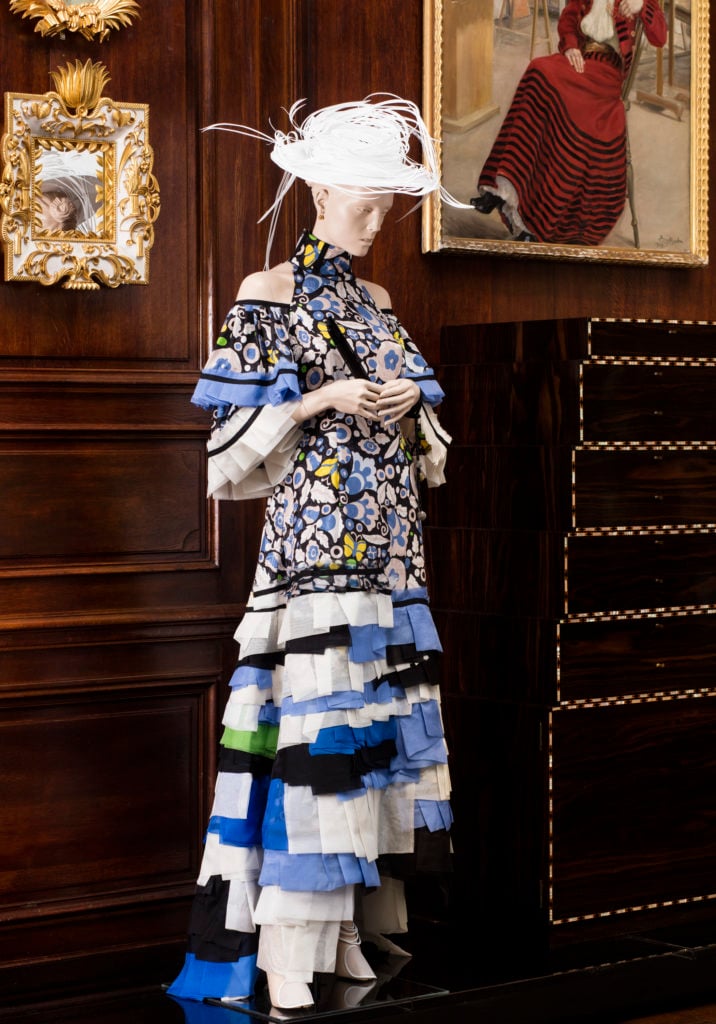
A Han Feng garment based on the designs of Viennese fashion designer Emilie Flöge. Courtesy of the Neue Galerie.
In addition to the two main galleries, a side room has been filled with Klimt’s sketches and studies, as well as photos taken of the artist and Flöge. One whole wall of these is dedicated to Bloch-Bauer, the striking silhouette of her profile instantly recognizable even in just a simple line drawing.
Paired with two full-length paintings that remain unfinished, this selection offers valuable insight to the artist’s practice, and the way that he built up his stunning fields of color.
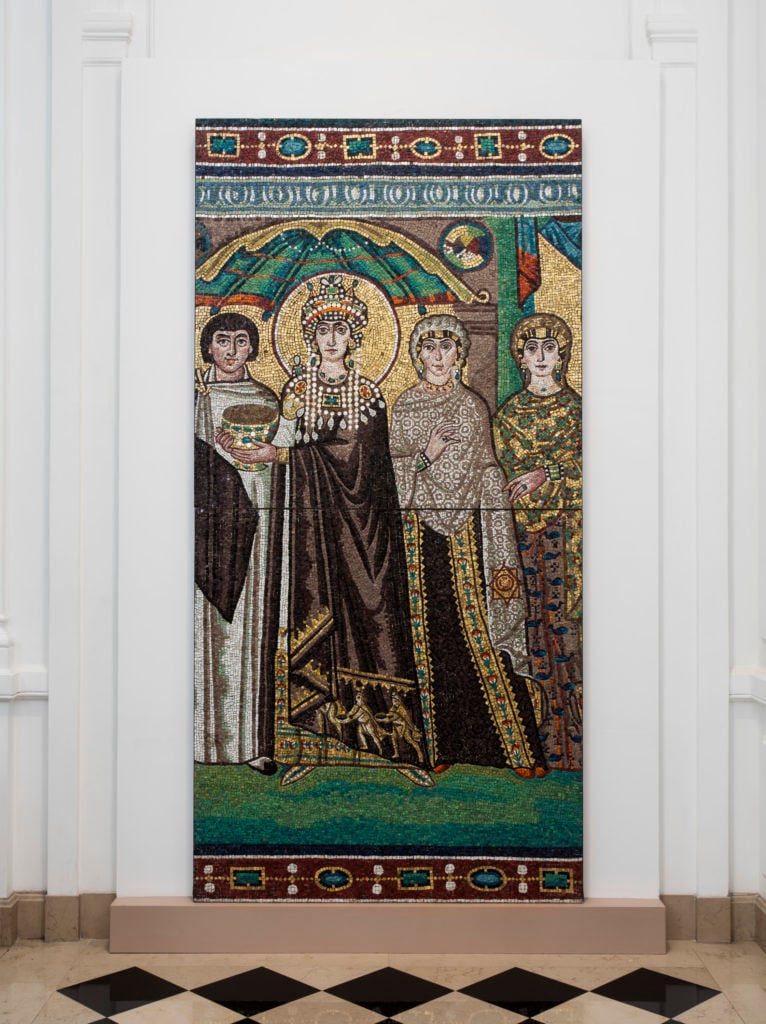
A replica of one of the famed 6th century Byzantine mosaics of Ravenna, Italy, featuring Empress Theodora. Courtesy of the Neue Galerie.
Also instructive is the inclusion of a replica of one of the famed 6th century Byzantine mosaics of Ravenna, Italy, featuring Empress Theodora. Klimt wrote to Flöge of their “unprecedented splendor” when he first saw the works in 1903, and the major influence the encounter had on his “Woman in Gold” canvas and other “golden style” works is undeniable.
What is clear, and what was understood during Klimt’s day, is that the artist successfully depicted a new type of woman, one who challenged the conventional role assigned to women by society. With this in mind, here’s a look at what art historians know about the seven women featured at the current exhibition, including Flöge.
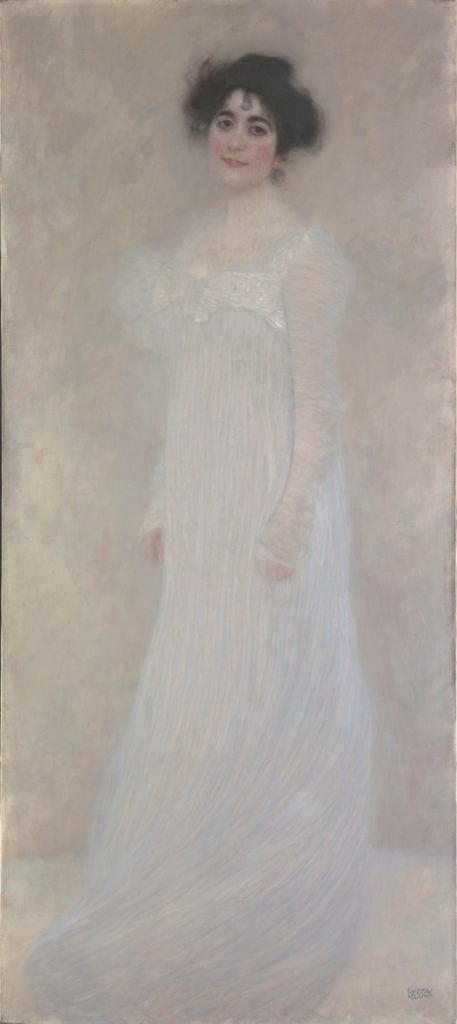
Gustav Klimt, Serena Pulitzer Lederer (1899). Courtesy of the Metropolitan Museum of Art.
Szerena Lederer
One of Klimt’s most dedicated patrons, Szerena Lederer was “renowned in the city [of Vienna] for her beauty,” as well as for being among its “best-dressed,” according to Tobias G. Natter’s essay in the exhibition catalogue.
Szerena Lederer amassed the largest private collection of work by the artist in the world. Her 1899 portrait was one of the artist’s very first portrait commissions, and a year after Klimt’s death, she is said to have bought an entire estate sale of his work in one fell swoop.
When the opportunity arose to purchase his 43-by-32-foot painting Philosophy, the Lederers ripped out a wall separating two rooms so there was somewhere to hang the work. The family also owned the artist’s only known work of sculpture, a large stone bust placed on the floor of the Lederer salon, beneath Szerena Lederer’s portrait.
Though she was unsuccessful in her efforts to commission a second Klimt portrait of herself, Szerena Lederer did get the artist to paint three generations of women in her family: her daughter, Elisabeth Lederer, and her mother, Charlotte Pulitzer, a close relative to newspaper scion Joseph Pulitzer, founder of the Pulitzer Prize. Natter called it “a one-of-its-kind family gallery like that of no other family in Vienna.”
Sadly, all but three works in the Lederer collection were seized by the Nazis and almost certainly burned during the war. Among those lost paintings was the 1917 portrait of Szerena Lederer’s mother, one of only three paintings Klimt made of elderly women (the others being of his and Flöge’s mothers), and one of the last works of his career.
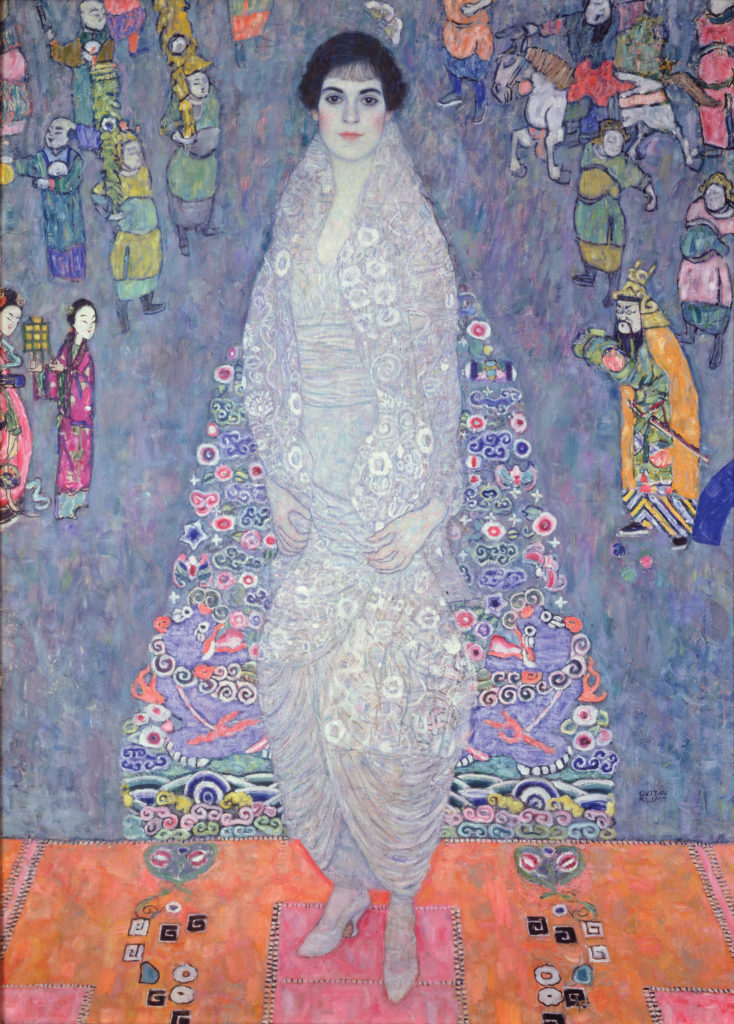
Gustav Klimt, Portrait of Elisabeth Lederer (1914–16). Courtesy of the Neue Galerie.
Elisabeth Lederer
Klimt, who had given her mother drawing lessons for years, encouraged Elisabeth Lederer to study at art school, and she ultimately had a public career as a sculptor in the 1930s.
Years earlier, between 1914 and 1916, Klimt worked on his portrait of Lederer. By now a close friend of the family, Klimt, who Elisabeth Lederer addressed as “Uncle,” labored over the piece. Legend has it that impatient Szerena Lederer ultimately took matters into her own hands, barging into the studio and making off with the canvas.
As the Nazis rose to power, the Lederers, a Jewish family, found themselves in peril. Elisabeth Lederer was married to a Protestant, but he filed for divorce in 1938, stripping her of her protected status just as Germany enacted the Anschluss of Austria.
Szerena Lederer took a stand for her daughter, and she swore under oath that Elisabeth Lederer was actually the biological daughter of Klimt, not her husband. (Both men were by then dead.) Art historians suspect she was lying out of desperation, but the Reich Department for Genealogical Research bought it, and Elisabeth Lederer escaped deportation.
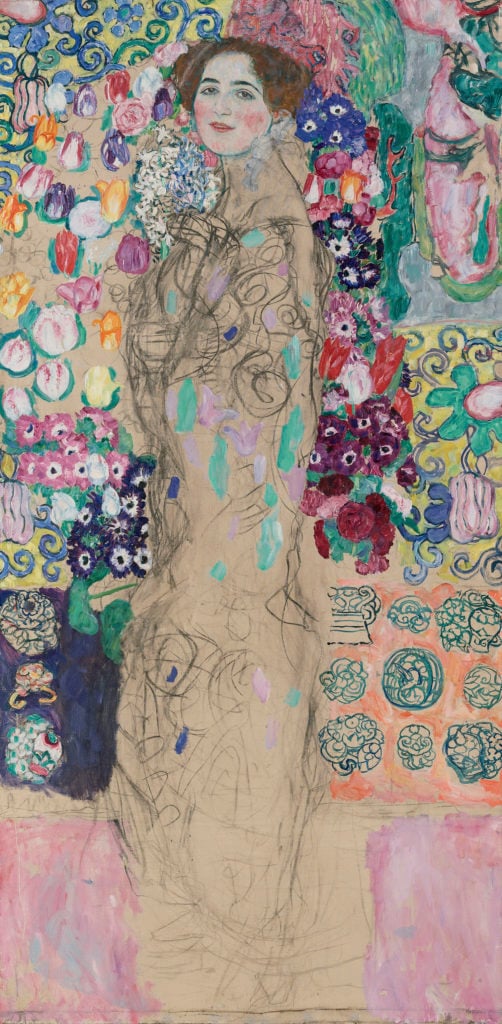
Gustav Klimt, Portrait of Ria Munk III (1917), unfinished. Courtesy of the Lewis Collection.
Ria Munk
There are not one but two unfinished works at the Neue Galerie thought to depict Ria Munk, Szerena Lederer’s niece. At age 24, in 1911, Munk committed suicide because of an “unhappy love affair” with writer Hanns Heinz Ewers, according to the catalogue.
Klimt was brought in to paint Munk on her deathbed, and he was commissioned to create a post-humous portrait two years later. Her family reportedly rejected the canvas, and it is believed he reworked it into Dancer, an unfinished piece of a woman in a floral patterned kimono that bears her breasts.
It is on display at the museum with Portrait of Ria Munk III (1917), which remained unfinished even as the artist’s third attempt to depict the young woman.

Gustav Klimt Portrait of Gertha Loew (1902). Courtesy of the Neue Galerie./the Lewis Collection
Gertha Loew
The exhibition catalogue cites Loew as one of a number of “Klimt’s women” who “achieved remarkable professional success.” Loew took over as chairwoman and principle shareholder of her father’s sanatorium, where Klimt was treated following his fatal stroke in 1918.
As Marian Bisanz-Prakken wrote in the exhibition catalogue, “the more interesting the woman to be depicted, the more Klimt allowed himself to be inspired by her.”
The portrait is thought to have been commissioned by Gertha Loew’s mother, Sophie, as present for her husband, Anton, at the time of their daughter’s marriage. Sophie knew Klimt well, and had been the subject of several of the artist’s portrait drawings some years before.
The painting remained in Austria after Gertha Loew and her children fled for the US in 1939. The person entrusted with selling the Klimt painting and the rest of her art collection on her behalf sold the works for their own gain, and The Portrait of Gertha Loew passed somehow to Klimt’s son.
It remained in the artist’s family, becoming part of the collection of the Klimt Foundation in Vienna, until Loew’s granddaughter, Andrea Felsovanyi, began fighting for its restitution earlier this decade. Upon its return, the work went up at auction in 2015, fetching $39 million at Sotheby’s London from British billionaire Joe Lewis.
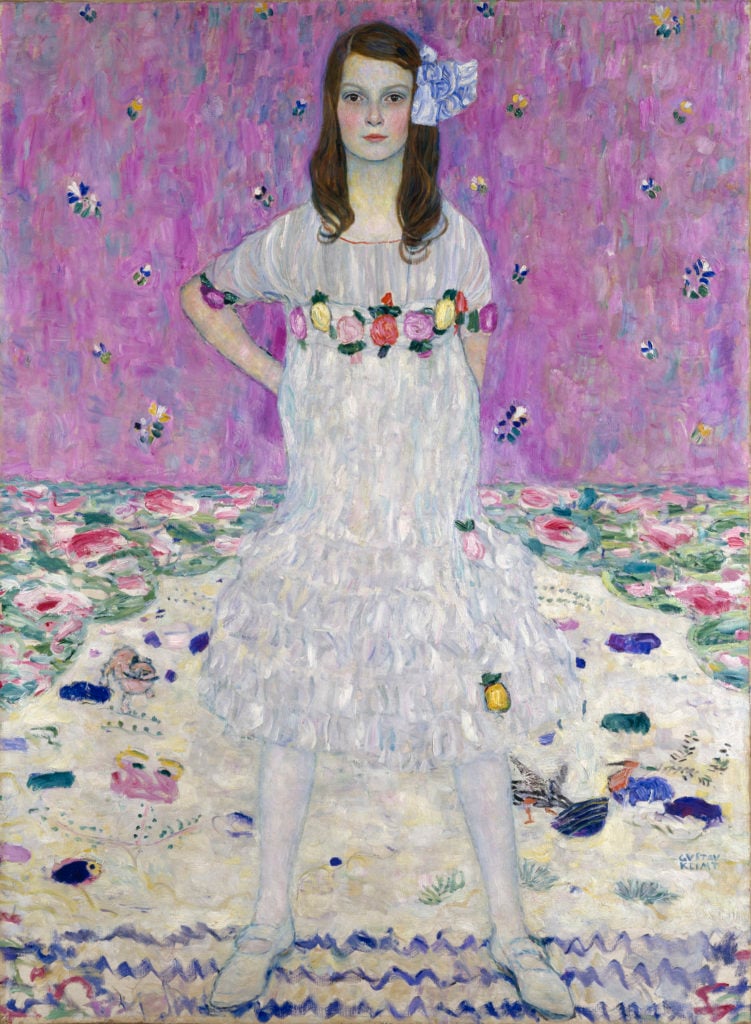
Gustav Klimt, Portrait of Mäda Primavesi (1912). Courtesy of the Neue Galerie and the Metropolitan Museum of Art.
Mäda Primavesi
A girl of just nine years old when Klimt painted her in 1912, Mäda Primavesi, who died in 2000, was the last person living to have watched Klimt at work. Remarkable for its bold, confident pose, and imposing stature, Primavesi’s portrait depicts a growing girl at the cusp of adolescence with remarkable sensitivity.
Her parents were among Klimt’s best collectors, and her mother, Eugenia, sat for her own portrait by the artist, a boldly colored yellow canvas covered in flowers, later that year. Primavesi’s flowered dress was made by Flöge, at Klimt’s suggestion, specifically for the portrait.
As an old woman, Primavesi brought her portrait to auction in New York in 1987. There, she posed with the work at the Metropolitan Museum of Art.

Gustav Klimt, Adele Bloch-Bauer II (1912). Courtesy of the Neue Galerie.
Adele Bloch-Bauer
Klimt’s iconic golden portrait of Adele Bloch-Bauer was years in the making: completed in 1907, the painting is mentioned in correspondence by the sitter as early as 1903. There are many unsubstantiated rumors that Klimt and Bloch-Bauer had an affair, though she was married to the industrialist Ferdinand Bloch, 17 years her senior. The two never had children.
Bloch-Bauer died in 1925, and her Klimt paintings eventually passed, against her wishes, to the Austrian state during the Nazi regime. Her various descendants, led by her niece Maria Altmann, spent years fighting to reclaim their inheritance. They finally triumphed in 2006.
After the case (depicted in the Helen Mirren film Woman in Gold) had closed, the paintings were sold, with the Neue Galerie buying Adele Block-Bauer I. The current exhibition is the first time since the sale that both portraits have been shown together.
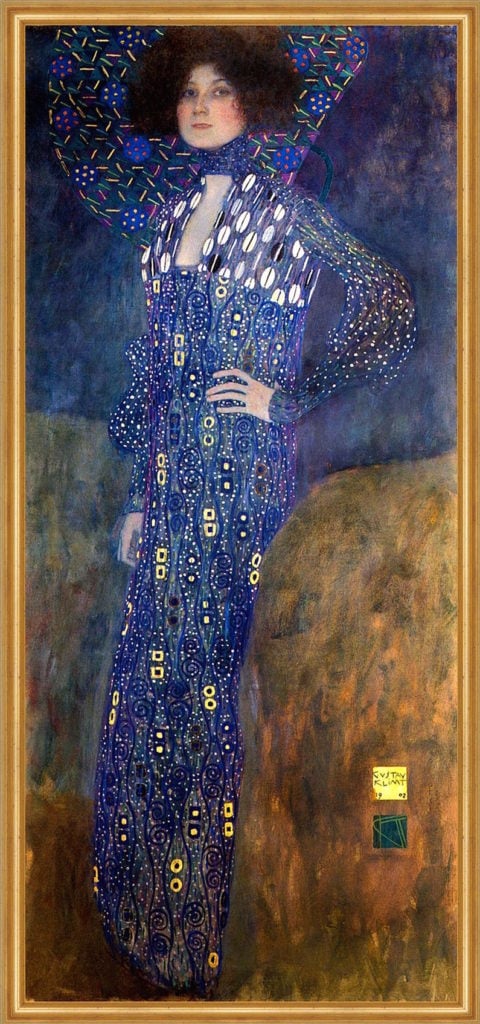
Gustav Klimt, Portrait of Emilie Flöge (1902–03). Courtesy of the Wien Museum, Vienna.
Emilie Flöge
The exhibition catalogue proclaims that “Klimt’s most important and enduring relationship was with Emilie Flöge, talented dress maker and successful business woman who was the artists’ lifetime companion and confidante.”
In 1892, after the death of Klimt’s brother, Ernst, who was married to Flöge’s sister, Klimt moved in with his sister-in-law, young nephew, and Flöge. There is no proof of a romantic attachment, but the two became incredibly close. Flöge dressed many of the women in Klimt’s portraits, and together they amassed an impressive collection of Eastern and European textiles, fueled in part by their shared love of Asian art.
“Marriage would have compromised her profession,” the catalogue claims, arguing that Flöge was far from a victim of Klimt’s philandering, and that “many feminists of the period would have considered [it] an ideal arrangement.”
Her designs were distinctly modern, a so-called reform dress that eschewed the restricting corset in favor of loosely flowing garments that offered a freedom and ease of motion. Klimt dressed many of his subjects in Flöge’s clothes.
She is said to be the model for Klimt’s famous painting The Kiss, as well as posing officially for him in a portrait completed in 1902–03.
“Gustav Klimt and the Women of Vienna’s Golden Age, 1900–1918” is on view at the Neue Galerie, 1048 Fifth Avenue, New York, September 22, 2016–January 16, 2017.